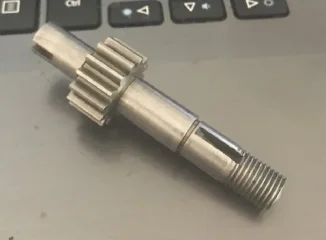The spindle does not become longer, the pump body becomes shorter (thinner). You could end up with gears that are thicker than the internal depth of the body. But then you should keep checking as you go. I suppose you could lap the gears back to the fit you needed. This is not a bad approach:
The workings of the oil pump
Look at the little gears in the pump and liken them to the paddles on a paddle wheel steamer; the gear teeth work the same as the paddles on those big wheels by pushing oil around, they can't do this successfully if the clearances on both sides of those lttle gears are excessive: meaning, the internal body side and the external end plate side.
Run a straight edge over the pump body and eyeball how much clearance there is between the body face and gear face; they should be almost flush with each other. Flatting down one face of the pump body is only solving half the problem, you've got to check the end float on the pinion shaft as excessive free play causes the gouging of the end plate in the first place.
To do the job properly you have got to completely dismantle the whole pump, separating gears from shafts. Square up the pinion side end plate first, reassemble the shafts and gears to this plate (the scavenge gears I think), put the body back in place, leave out the second set of gears, replace the end plate, tighten up and check to see if there is any binding. There should be slight resistance to turning the pinion with thumb and finger and no discernable end play.
The next step is to disassemble, leave out the first set of gears, pop the body on the pinion end plate and put the second set of gears in place. Replace the end plate, tighten up and check for perceptible end play and a slight resistance to turning. The body can be flatted down to correct any excess clearance between gear face and body face; you can fart about with feeler gauges if you must but it's just as easy to hold it up to the light and check for a tiny amount of light between the straight edge and the gear face. A bees dick or a poofteenth is plenty. Be very careful about how much you flatten the end plate as the holes are threaded (BA if memory serves) and are very fine.
If the threads are buggered, you can buy longer bolts and nuts from model engineering suppliers or do as I did, go down to your hardware suppliers buy suitable metric stainless bolts and enough nuts to be able to 'double-nut' with Loctite fluid. Four years and 18,000 km down the track I have had no problems (touch wood) and still have 40 p.s.i. hot oil pressure at 3000 r.p.m. (my oil gauge is teed off the rocker supply so must truly read a lot higher).
Be aware also that the oil pump to crankcase seals are different for the Mk.lll and earlier machines. The Mk.lll is a conical shape whereas the earlier ones are flat. The same could possibly apply to the crank oil seal as well; the Mk.lll one has the wire coil assister fitted and the lip face looks different as well.


